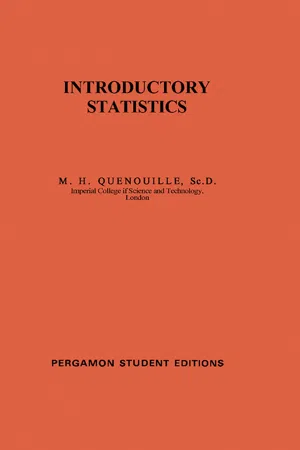Psychology
Sampling Methods
Sampling methods in psychology refer to the techniques used to select a representative group of participants from a larger population for research purposes. Common sampling methods include random sampling, stratified sampling, and convenience sampling. The choice of sampling method can impact the generalizability of study findings to the larger population.
Written by Perlego with AI-assistance
Related key terms
1 of 5
12 Key excerpts on "Sampling Methods"
- No longer available |Learn more
- Frederick J Gravetter; Lori-Ann B. Forzano; Tim Rakow, Frederick Gravetter, Frederick Gravetter, Lori-Ann Forzano, Tim Rakow(Authors)
- 2021(Publication Date)
- Cengage Learning EMEA(Publisher)
DEFINITIONS Sampling is the process of selecting individuals to participate in a research study. In probability sampling, the entire population is known, each individual in the population has a specifi- able probability of selection, and sampling occurs by a random process based on the probabilities. A random process is a procedure that produces one outcome from a set of possible outcomes. The outcome must be unpredictable each time, and the process must guarantee that each of the possible outcomes is equally likely to occur. In non-probability sampling, the population is not completely known, individual probabilities cannot be known, and the sampling method is based on factors such as commonsense or ease, with an effort to maintain representativeness and avoid bias. In the following sections, we discuss five probability Sampling Methods (simple random, systematic, stratified, proportionate stratified and cluster sampling) and two non-probability Sampling Methods (convenience and quota sampling). For each method, the general goal is to obtain a sample that is Copyright 2021 Cengage Learning. All Rights Reserved. May not be copied, scanned, or duplicated, in whole or in part. Due to electronic rights, some third party content may be suppressed from the eBook and/or eChapter(s). Editorial review has deemed that any suppressed content does not materially affect the overall learning experience. Cengage Learning reserves the right to remove additional content at any time if subsequent rights restrictions require it. C H A P T E R 5 / Selecting Research Participants 116 representative of the population from which it is taken. For different kinds of research, however, the defi- nition of representative varies; hence, there are several well-defined sampling procedures that attempt to produce a particular kind of representation. L E A R N I N G C H E C K 1. Dr Near conducts an experiment on memory for individuals who are above the age of 65. - eBook - PDF
Research Methods
A Tool for Life
- Bernard C. Beins(Author)
- 2017(Publication Date)
- Cambridge University Press(Publisher)
People from different backgrounds may respond in dif- ferent ways to the same stimulus. So concepts may take on different operational definitions in different cultural contexts. In addition to specifying operational definitions, researchers must also decide who they are going to sample and how they are going to do it. One general classification is called probability sampling. This approach requires identification of the population of interest and a well-specified means of selecting individuals for the research. The simplest and most well-known type is simple random sampling, in which every person in the popu- lation has an equal chance to participate in the research. But there are also complicated designs involving probability sampling. The benefit of these approaches is that researchers can be confident that the sample represents the population. A more common approach in psychology is to use nonprobability samples. The main nonprobability approach is to use convenient samples, often of college students. Although these samples are quite convenient, there is some concern that the results may not pertain to a wider population. MEASUREMENT AND SAMPLING 119 After researchers collect their data, they must face the question as to whether their measurements and their results are reliable. That is, if the investigators were to conduct another similar study, would they obtain the same results? If measurements and results are reliable, they may also be valid. That is, the measurements and results might help answer the researchers’ questions. There are multiple forms of reliability and validity that are relevant in different circumstances. Finally, when researchers collect their data, the results are sometimes qualitative, involving how many observations fall into a category. At other times, the results are quantitative, leading to various types of statistical analysis. - Aparna Raghvan(Author)
- 2020(Publication Date)
- Society Publishing(Publisher)
3. Pretesting Survey Items: Covers expert review, cognitive interviews, focus groups, and field testing. 4. Sampling: It mainly includes random sampling, sampling frames, census, stratification, and other considerations. 5. Administering the Survey: It comprises online surveys, personal interviews, and mailed surveys. 6. Calculating Response Rates: It includes maximizing response rates, calculating response rates, and measuring non-response bias. Survey Methods in Research and Evaluation of Education ... 195 7. Setting up a Focus Groups (as an alternative to a survey or to complement a survey project): It covers the primary objective of focus groups, selecting focus group members, preparing protocols, moderator strategies, collection as well as analysis of data. 8.4. 6 KEY METHODS OF EDUCATION PSYCHOLOGY There are basically six important methods of education psychology. The methods are: 1. Introspection; 2. The observational method; 3. The experimental method; 4. The clinical method; 5. The genetic or developmental method; 6. The testing methods. Psychology is defined as the systematic and scientific study of human behavior. It comprises its own special tools and procedures. These tools and procedures play a very important role in analyzing, organizing, and gathering its subject-matter or the essential facts about it. These procedures are called its methods, which we will discuss in this section.These methods have to be scientific, systematic, and consistent if the knowledge that one obtains from these is used for scientific purposes. Educational psychology uses all these principal methods of psychology. Apart from these methods, there are some other essential methods that are used by educational psychologists in the collection and organization of necessary data. 8.4.1. Introspection The Introspection method is one of the older methods and is peculiar to psychology.- eBook - PDF
- R. D. Savage(Author)
- 2013(Publication Date)
- Pergamon(Publisher)
IV. PSYCHOMETRIC AND STATISTICAL TECHNIQUES This page intentionally left blank CHAPTER 20 Sampling in Psychological Researcht Q. MCNEMAR Stanford University, California, U.S.A. INTRODUCTION One does not have to read much of the current research literature in psychology, particularly in individual and social psychology, to realize that there exists a great deal of confusion in the minds of investigators as to the necessity of obtaining a truly representative sample, describing care-fully how the sample was secured, and restricting generalizations to the universe, often ill-defined, from which the sample was drawn. There would seem to be a blind faith in, for instance, the neat formula σ Μ = σ/]/ Ν, the very simplicity of which belies the fact that certain definite conditions must be met before it is permissible to draw deductions thereform. Perhaps the sampling inadequacy of so many researches is merely a reflection of the scanty treatment of sampling in the typical American textbooks on statistical method. Usually, but not always, something is said in the texts concerning the desirability or necessity of securing a represen-tative sample and the possibility of sampling bias, but the specific methods for drawing a sample, checking its representativeness, and avoiding bias are left to the imagination of the reader. This state of affairs is, in part, due to the scarcity of specific techniques for drawing a sample and of methods for checking bias. This scarcity, however, is no excuse for ignoring the funda-mental conditions for drawing a random sample, nor does it justify the pro-mulgation of methods for checking representativeness which are decidedly questionable. The writer considers it axiomatic that a large amount of psychological research must, of necessity, depend upon sampling for the simple reason that human variation exists. - eBook - PDF
Statistical Quality Control
Using MINITAB, R, JMP and Python
- Bhisham C. Gupta(Author)
- 2021(Publication Date)
- Wiley(Publisher)
4 Sampling Methods 4.1 Introduction The science of sampling is as old as civilization. When trying a new cuisine, for example, we take only a small bite to decide whether the taste of the food is to our liking. However, modern advances in sampling techniques have only taken place starting in the twentieth century. Now sampling is a matter of routine, and the effects of the outcomes can be felt in our day-to-day lives. Most decisions about government policies, marketing, trade, and manufacturing are based on the outcomes of sampling conducted in different fields. There are various types of sampling. The particular type of sampling used for a given situation depends on factors such as the composition of the population, objectives of the sampling, or simply time and budgetary constraints. Since sampling is an integral part of statistical quality control, we dedicate this chapter to the study of various types of sampling and estimation problems. 4.2 Basic Concepts of Sampling The primary objective of sampling is to use the information contained in a sample taken from some population to make inferences about a certain population parameter, such as the population mean, population total, population proportion, or population variance. To make such inferences in the form of estimates of parameters that otherwise are unknown, we collect data from the population of interest. The aggregate of these data constitutes a sample. Each data point in the sample provides us with some information about the population parameter. However, since collecting each data point costs time and money, it is important to keep a balance. Too small a sample may not provide enough information to obtain good estimates, and too large a sample may result in a waste of resources. Thus, it is very important that in any sampling procedure, an appropriate sampling scheme, normally known as the sample design, is put in place. - Stephen Gorard(Author)
- 2003(Publication Date)
- Continuum(Publisher)
Nineteenth-century psychol-ogy was often based on what researchers found out about themselves (introspection), while later twentieth-century psychology was chiefly based on what psychologists found out about each other. There are some hopeful signs that in the twenty-first century psychology is becoming more concerned with people at large. NON-PROBABILITY SAMPLES An implicit assumption has been made in the chapter so far that our sample will be what is termed a 'probability' sample, where cases will be selected either randomly or systematically. There are two good reasons for this focus. First: this kind of sampling is generally more technical than its alternatives, so requiring more explanation for a new researcher. Second: this kind of sampling is preferable in 72 Quantitative Methods in Social Science almost every way to any of its alternatives in all research situations. Thus, a simple guideline would be that probability samples should be used in all circumstances in which they are possible. A high-quality sample is crucial for safe generalization to take place (for high 'external validity'). Non-probability samples should therefore be reserved only for those projects in which there is no other choice. The most common and over-used form of non-probability sampling is the convenience sample, composed of those cases chosen only because they are easily available. A researcher standing in a railway station or shopping centre or outside a student union and stopping people in an ad hoc manner would thereby create a convenience sample and not a random one. This approach is often justified by the comment that a range of people use such places, so the sample will be mixed in composition. The approach is sometimes strengthened, for example in market 'research', by determining quotas for groups of cases (such as men and women) and then deselecting people (e.g. by not stopping them) once the quota for each group is filled.- eBook - PDF
Research Methods For Business
A Skill Building Approach
- Uma Sekaran, Roger Bougie(Authors)
- 2020(Publication Date)
- Wiley(Publisher)
CHAPTER 14 221 Sampling LEARNING OBJECTIVES After completing Chapter 14, you should be able to: 1. Define sampling, sample, population, element, sampling unit and subject. 2. Discuss statistical terms in sampling. 3. Describe and discuss the sam-pling process. 4. Compare and contrast specific prob-ability sampling designs. 5. Compare and contrast specific non-probability sampling designs. 6. Discuss precision and confidence and the trade-off between precision and confidence. 7. Discuss how hypotheses can be tested with sample data. 8. Discuss the factors to be taken into consideration for determining sam-ple size and determine the sample size for any given research project. 9. Discuss sampling in qualita-tive research. 10. Discuss the role of the manager in sampling. Experimental designs and surveys are useful and powerful in finding answers to research ques-tions through data collection and subsequent analyses, but they can do more harm than good if the population is not correctly targeted. That is, if data are not collected from the people, events or objects that can provide the correct answers to solve the problem, the research will be in vain. The process of selecting the right individuals, objects or events as representatives for the entire population is known as sampling , which we will examine in some detail in this chapter (see shaded portion in Figure 14.1). The reasons for using a sample, rather than collecting data from the entire population, are self-evident. In research investigations involving several hundreds and even thousands of elements, it would be practically impossible to collect data from, or test, or examine, every element. Even if it were possible, it would be prohibitive in terms of time, cost and other resources. Study of a sample rather than the entire population is also sometimes likely to pro-duce more reliable results. - eBook - PDF
- M.H. Quenouille(Author)
- 2014(Publication Date)
- Pergamon(Publisher)
9 Sampling Methods 9.1 Random selection —The application of statistical method depends largely upon the approach in which the chances against a set of observations arising naturally under a given hypothesis are calculated and if these chances are small the hypothesis is rejected. The idea of chance variation plays a large part in this approach. For example, if the accuracy of a mean is being determined, it is assumed that the individual observations constitute a reasonable selection of the whole. For this to be so the method of making the observations must be above criticism. As explained in section 1.1, any series of observations can be considered as a sample from a population of possible observations, so that the correct method of obtaining a sample set of observations is of some importance. In sampling two main conditions should be satisfied: first, the sample should be unbiased and secondly, it should yield information on its own accuracy. These conditions have been adequately summarized by F. YATES who writes: 1 If bias is to be avoided, the selection of samples must be determined by some process uninfluenced by the qualities of the objects sampled and free from any element of choice on the part of the observer. 2 If a valid estimate of sampling error is to be available each batch of material must be so sampled that two or more sampling units are obtained from it. These sampling units must be a random selection from the whole aggregate of sampling units that can be taken from the batch of material, and all the sampling units in the aggregate must be of approximately the same size and pattern, and must together comprise the whole of the batch of material. For the moment we shall consider the first problem: how to obtain an unbiased sample. This is not as easy at it appears, for the personal element intrudes. Conscious or unconscious selection by the observer occurs very easily, and where human beings are observed they often tend to influence their observers. - Ronald C. Martella, J. Ron Nelson, Robert L. Morgan, Nancy E. Marchand-Martella(Authors)
- 2013(Publication Date)
- The Guilford Press(Publisher)
Convenience Sampling Convenience sampling involves using those individuals, objects, or events that are available to the researcher. Although convenience sam- pling is an easy way for researchers to gener- ate samples, the samples tend not to be repre- sentative of the population. The usual method of putting together a convenience sample is for researchers to use members of a population who are available. For example, a professor in psychology includes all of the students enrolled in an Introduction to Psychology class to explore some psychological phenomenon. Convenience sampling results in a sample that is represen- tative of the population only if the group of individuals, events, or objects available to the researcher are representative of a population. If this is not the case, generalizing beyond the members of the sample would be problematic. Opportunity Sampling Opportunity sampling is similar to convenience sampling in that researchers use individuals, objects, or events that are readily available. However, opportunity sampling means using members of the population who are willing to take part in the research. For example, using our college course example, the professor includes students enrolled in an Introduction to Psy- chology class who are willing to participate in the research study. In contrast to convenience sampling, opportunity sampling rarely results in representative samples. Thus, any inferences made beyond the members of the sample are problematic. Volunteer Sampling Volunteer sampling involves directly advertis- ing for participants in a research study. The dis- tinguishing aspect of volunteer sampling is that participants are self-selected; that is, rather than researchers approaching each member of the population to ask if he/she wants to be included in the sample, the volunteers approach the researchers and ask to participate in the study.- eBook - PDF
Research Methods For Business
A Skill Building Approach
- Roger Bougie, Uma Sekaran(Authors)
- 2021(Publication Date)
- Wiley(Publisher)
CHAPTER 14 221 Sampling LEARNING OBJECTIVES After completing Chapter 14, you should be able to: 1. Define sampling, sample, population, element, sampling unit and subject. 2. Discuss statistical terms in sampling. 3. Describe and discuss the sam- pling process. 4. Compare and contrast specific prob- ability sampling designs. 5. Compare and contrast specific non- probability sampling designs. 6. Discuss precision and confidence and the trade-off between precision and confidence. 7. Discuss how hypotheses can be tested with sample data. 8. Discuss the factors to be taken into consideration for determining sam- ple size and determine the sample size for any given research project. 9. Discuss sampling in qualita- tive research. 10. Discuss the role of the manager in sampling. Experimental designs and surveys are useful and powerful in finding answers to research ques- tions through data collection and subsequent analyses, but they can do more harm than good if the population is not correctly targeted. That is, if data are not collected from the people, events or objects that can provide the correct answers to solve the problem, the research will be in vain. The process of selecting the right individuals, objects or events as representatives for the entire population is known as sampling, which we will examine in some detail in this chapter (see shaded portion in Figure 14.1). The reasons for using a sample, rather than collecting data from the entire population, are self-evident. In research investigations involving several hundreds and even thousands of elements, it would be practically impossible to collect data from, or test, or examine, every element. Even if it were possible, it would be prohibitive in terms of time, cost and other resources. Study of a sample rather than the entire population is also sometimes likely to pro- duce more reliable results. - eBook - PDF
Measuring Customer Satisfaction and Loyalty
Survey Design, Use, and Statistical Analysis Methods
- Bob E. Hayes(Author)
- 2008(Publication Date)
- ASQ Quality Press(Publisher)
83 5 Sampling Methods S ometimes it is not possible to administer surveys to all your customers. Organizations with tens of thousands of customers may not have the resources to conduct a large-scale project. In fact, it may not be necessary to survey all of a company’s clients in order to get a reliable picture regarding levels of customer satisfaction. This chapter will cover Sampling Methods and related topics: determining sample size, determining confidence levels, and increasing response rates to written surveys. STATISTICAL SAMPLING We often make judgments about a large group of “things” based on our observations of a smaller subset of those “things.” For example, we talk to a few customers in order to learn about the quality of service we provide to all of our customers. In quality improvement organizations, someone checks a selection of products in order to determine whether there may be major problems with the entire lot. To determine the quality of coffee beans from a roaster, the tester tastes a small handful of beans taken from that roaster. When preparing a stew, the chef might taste a small spoonful from the pot in which the stew is cooking in order to determine whether the entire pot is ready. In these examples, people have drawn conclusions about something in its entirety (such as all the soup or all the coffee beans) from a small subset of its content (a spoonful of soup or a handful of beans). We typically refer to the large group as the population and the small subset of that group as the sample. (See Appendix F for a more detailed description of the characteristics of populations and samples.) When conducting a customer satisfaction survey, we typically cannot administer the survey to the entire customer base. We may not have the financial resources, or we may need the results of the survey immediately, which would preclude the time-consuming task of measuring all customers’ attitudes. - Lorelle J. Burton, Drew Westen, Robin M. Kowalski(Authors)
- 2022(Publication Date)
- Wiley(Publisher)
The psychologist begins by interviewing a small sample of employees, from executives to workers on the line, and then designs a survey, which is completed by a random sample of workers in randomly selected plants around the country. The survey asks workers to rate a series of statements, such as ‘My job does not pay well’, ‘I do not receive enough holiday time’ and ‘I feel like I do not learn anything on the job’, on a seven-point scale (where 1 = strongly disagree and 7 = strongly agree). The two most frequently used tools of survey researchers are interviews, in which researchers ask questions using a standard format, usually to a large sample of participants, and questionnaires, which participants fill out by themselves. Selecting the sample is extremely important in survey research. For example, pollsters conducting voter exit interviews must be sure that their sample reflects a large and heterogeneous population if they are to predict election results accurately. Researchers typically want a random sample, a sample selected from the general population in a relatively arbitrary way that does not introduce any systematic bias. In random sampling, every member of a population has an equal chance of being selected for the sample. The organisational psychologist seeking a random sample of factory workers in a company, for instance, might choose names randomly selected from payroll or personnel records. APPLY AND DISCUSS • In surveys, or in any other studies, can we ever justify a focus on one or more genders? • Under what circumstances can we assume or not assume that different groups of people (such as peo- ple of different ethnicities) will have similar psychologi- cal characteristics? Random selection, however, does not always guarantee that a sample will accurately reflect the demographic characteristics (qualities such as gender, race and socioeconomic status) of the population in which the researcher is interested.
Index pages curate the most relevant extracts from our library of academic textbooks. They’ve been created using an in-house natural language model (NLM), each adding context and meaning to key research topics.











